Now, your sweat can be used to power wearable devices
Researchers have developed stretchable fuel cells that extract energy from sweat and are capable of powering electronics such as LEDs and Bluetooth radios.
In a paper published in the journal Energy & Environmental Science, the researchers described how they connected the biofuel cells to a custom-made circuit board and demonstrated that the device was able to power an LED while a person wearing it exercised on a stationary bike. The biofuel cell that the engineers from the University of California, San Diego developed can stretch and flex like the human body.
The research led by Professor Joseph Wang, who directs the Center for Wearable Sensors at the university, used a combination of clever chemistry, advanced materials, and electronic interfaces. The researchers explained that biofuel cells were equipped with an enzyme that oxidises the lactic acid present in human sweat to generate current. This turned the sweat into a source of power. To make the biofuel cells flexible and stretchable, the engineers decided to use what they call a 'bridge-and-island' structure developed in Professor Sheng Xu's research group. Essentially, the cell is made up of rows of dots that are each connected by spring-shaped structures. Half of the dots make up the cell's anode and the other half are the cathode.

The spring-like structures can stretch and bend, making the cell flexible without deforming the anode and cathode. The basis for the bridge-and-island structure was manufactured via lithography and is made of gold. As a second step, researchers used screen printing to deposit layers of biofuel materials on top of the anode and cathode dots. The researchers' biggest challenge was increasing the biofuel cell's energy density, meaning the amount of energy it can generate per surface area.
Increasing energy density is key to increasing performance for the biofuel cells. The more energy the cells can generate, the more powerful they can be. To increase power density, engineers screen printed a 3D carbon nanotube structure on top of the anodes and cathodes. The structure allows engineers to load each anodic dot with more of the enzyme that reacts with lactic acid and silver oxide at the cathode dots. In addition, the tubes allow easier electron transfer, which improves biofuel cell performance, the study said.
With inputs from IANS.
Do you have an interesting story to share? Please write to us at [email protected]. To stay updated with more positive news, please connect with us on Facebook and Twitter.







